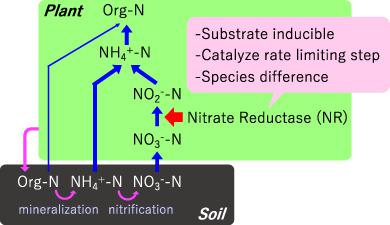当前位置:
X-MOL 学术
›
Ecol. Res.
›
论文详情
Our official English website, www.x-mol.net, welcomes your feedback! (Note: you will need to create a separate account there.)
Nitrate reductase activities in plants from different ecological and taxonomic groups grown in Japan
Ecological Research ( IF 2 ) Pub Date : 2020-01-19 , DOI: 10.1111/1440-1703.12083 Lina A. Koyama 1, 2 , Masakazu Terai 1, 3 , Naoko Tokuchi 4
Ecological Research ( IF 2 ) Pub Date : 2020-01-19 , DOI: 10.1111/1440-1703.12083 Lina A. Koyama 1, 2 , Masakazu Terai 1, 3 , Naoko Tokuchi 4
Affiliation

|
Plants generally use soil inorganic nitrogen, ammonium (NH4+–N), and nitrate (NO3−–N) as sources of nitrogen, an essential nutrient. The assimilation processes after uptake differ considerably from ammonium to nitrate. Nitrate must be reduced to ammonium in plant tissue before it is synthesized to amino acids, while ammonium is directly and immediately synthesized to amino acids after its uptake. Nitrate reductase is an enzyme that catalyzes the first and rate‐limiting step of nitrate assimilation, reducing nitrate to nitrite. It is a substrate‐inducible enzyme, and the capacity to induce nitrate reductase varies greatly among plant species. In vivo nitrate reductase activity (NRA) is generally measured as a nitrite production rate during incubation using fine cut pieces of plant tissue, and it is applicable as an indicator on plant nitrate use. Here we present in vivo NRA of leaves from a total of 108 species including arboreal trees, small trees, shrubs, herbs, a vine and a moss. For 75 of the species, NRA in fine roots was also determined. At least 20 species in sampled plants were imported and planted for scientific or industrial purposes, but most sampled species were native to Japan. Several inventory studies of plant NRA have been conducted, mainly in Europe, and they provided information on the species‐specific capacity of nitrate use by plants in Europe. However, to our best knowledge, there has been hitherto no published inventory of the NRA of plants in Japan where many endemic species are distributed. Our dataset contains plant NRA with species, family name, life form, leaf lifespan (evergreen or deciduous), growth stage, the season of sample collection, growth conditions (natural or cultivated) and other treatments/conditions when applicable. The data provided by this study may contribute to future works that require information regarding the plant species characteristics for nitrate use capacity or nitrate preference.
中文翻译:

日本生长的不同生态和分类组植物的硝酸还原酶活性
植物一般采用土壤无机氮,铵(NH 4 + N),和硝酸盐(NO 3 --N)作为必需营养素的氮源。吸收后的吸收过程从铵到硝酸盐有很大不同。硝酸盐必须先在植物组织中还原为铵,然后才能合成为氨基酸,而铵在吸收后直接直接合成为氨基酸。硝酸还原酶是一种催化硝酸盐同化的第一步和限速步骤,将硝酸盐还原为亚硝酸盐的酶。它是一种底物诱导酶,诱导硝酸还原酶的能力在植物物种之间有很大差异。体内硝酸盐还原酶活性(NRA)通常使用细切的植物组织碎片作为孵化过程中亚硝酸盐的产生速率进行测量,并且可作为植物硝酸盐使用的指标。在这里,我们介绍了来自树种,小树,灌木,草本植物,藤本植物和苔藓的总共108种植物的叶片体内NRA。对于其中的75种,还测定了细根中的NRA。出于科学或工业目的,至少进口了20种采样植物并进行了种植,但大多数采样物种是日本本土的。主要在欧洲对植物NRA进行了一些清单研究,它们提供了有关欧洲植物对硝酸盐使用的物种特定能力的信息。但是,据我们所知,迄今为止,日本尚未发布许多分布有特有物种的植物的NRA清单。我们的数据集包含植物NRA的种类,家族名称,生命形式,叶片寿命(常绿或落叶),生长阶段,样品采集的季节,生长条件(自然或耕作)和其他适用的处理方法/条件。这项研究提供的数据可能有助于将来的工作,这些工作需要有关硝酸盐使用能力或硝酸盐偏好的植物物种特征信息。
更新日期:2020-01-19
中文翻译:

日本生长的不同生态和分类组植物的硝酸还原酶活性
植物一般采用土壤无机氮,铵(NH 4 + N),和硝酸盐(NO 3 --N)作为必需营养素的氮源。吸收后的吸收过程从铵到硝酸盐有很大不同。硝酸盐必须先在植物组织中还原为铵,然后才能合成为氨基酸,而铵在吸收后直接直接合成为氨基酸。硝酸还原酶是一种催化硝酸盐同化的第一步和限速步骤,将硝酸盐还原为亚硝酸盐的酶。它是一种底物诱导酶,诱导硝酸还原酶的能力在植物物种之间有很大差异。体内硝酸盐还原酶活性(NRA)通常使用细切的植物组织碎片作为孵化过程中亚硝酸盐的产生速率进行测量,并且可作为植物硝酸盐使用的指标。在这里,我们介绍了来自树种,小树,灌木,草本植物,藤本植物和苔藓的总共108种植物的叶片体内NRA。对于其中的75种,还测定了细根中的NRA。出于科学或工业目的,至少进口了20种采样植物并进行了种植,但大多数采样物种是日本本土的。主要在欧洲对植物NRA进行了一些清单研究,它们提供了有关欧洲植物对硝酸盐使用的物种特定能力的信息。但是,据我们所知,迄今为止,日本尚未发布许多分布有特有物种的植物的NRA清单。我们的数据集包含植物NRA的种类,家族名称,生命形式,叶片寿命(常绿或落叶),生长阶段,样品采集的季节,生长条件(自然或耕作)和其他适用的处理方法/条件。这项研究提供的数据可能有助于将来的工作,这些工作需要有关硝酸盐使用能力或硝酸盐偏好的植物物种特征信息。



























 京公网安备 11010802027423号
京公网安备 11010802027423号